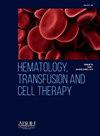EVALUATION OF THE AFFINITY OF RADIOLABELED PEPTIDE [¹³¹I]I-DEDEYFELV FOR EGFR-OVEREXPRESSING RECEPTORS IN ADULT-TYPE DIFFUSE GLIOMAS
IF 1.8
Q3 HEMATOLOGY
引用次数: 0
Abstract
Introduction/Justification
Cancer remains one of the leading causes of death worldwide. Among the various tumor sites, the central nervous system is particularly significant, with gliomas accounting for the majority of primary brain tumors. In gliomas, alterations in the tyrosine kinase pathway lead to the overexpression of the Epidermal Growth Factor receptor (EGFr). Over the past decades, radiolabeled peptides with high affinity for EGFr have emerged as promising molecular targets with potential applications in both diagnosis and therapy.
Objectives
This study aimed to evaluate the affinity of the peptide DEDEYFELV, radiolabeled with iodine-131 (¹³¹I), for EGFr-overexpressing receptors in adult-type diffuse gliomas using tumor tissue samples.
Materials and Methods
The peptide was synthesized using solid-phase peptide synthesis following the Fmoc/tBu strategy. Upon completion of the synthesis, the peptide was characterized and purified via high-performance liquid chromatography (HPLC). DEDEYFELV (20 nmol) was radiolabeled with [¹³¹I]NaI (18.5 MBq) using the chloramine-T method. The radiochemical yield of [¹³¹I]I-DEDEYFELV was determined via chromatography on Whatman 3MM strips using a 95% MeOH / 5% H₂O eluent. Binding studies of [¹³¹I]I-DEDEYFELV with neoplastic tissue homogenates were conducted at 1 and 4 h of incubation and quantified using an automatic gamma counter. Tumor tissue homogenates were obtained from surgical resections performed by a designated neurosurgeon, following informed consent. Gliomas were confirmed through pathological analysis, and tumor samples were preserved at -80°C. All human protocols adhered to local ethical guidelines (Protocol number CEP – FCMSCSP: CAAE 79336124.7.0000.5479). Statistical analysis was conducted using ANOVA or Student's t-test.
Results
The peptide DEDEYFELV was successfully synthesized with a yield of approximately 92%. Mass spectrometry and HPLC analyses confirmed efficient synthesis, cleavage, and purification, as evidenced by a single peak and a molecular mass corresponding to the expected peptide. Radiolabeling was achieved with a radiochemical yield exceeding 95%. Binding studies of [¹³¹I]I-DEDEYFELV with neoplastic tissue homogenates showed values of 3.25 ± 0.31% for high-grade tumors, 2.62 ± 0.34% for low-grade tumors, and 1.61 ± 0.25% for tumors of unknown grade at 1 h of incubation (n = 5). At 4 h, the binding values increased to 6.45 ± 0.66% for high-grade tumors, 10.27 ± 1.58% for low-grade tumors, and 7.74 ± 1.21% for tumors of unknown grade (n = 5).
Conclusion
These findings demonstrate that the radiolabeled peptide [¹³¹I]I-DEDEYFELV exhibits specific binding to EGFr-overexpressing tumor tissues, with an increasing affinity over time. The higher binding observed at 4 h suggests favorable interaction dynamics, particularly in low-grade gliomas. These results highlight the potential of [¹³¹I]I-DEDEYFELV as a theranostic agent for EGFr-targeted imaging and therapy, warranting further investigations into its in vivo stability and clinical applicability.
导言/理由癌症仍然是导致全球死亡的主要原因之一。在各种肿瘤部位中,中枢神经系统的肿瘤尤为突出,胶质瘤占原发性脑肿瘤的大多数。在胶质瘤中,酪氨酸激酶通路的改变导致表皮生长因子受体(EGFr)过度表达。在过去的几十年中,对 EGFr 具有高亲和力的放射性标记肽已成为有望应用于诊断和治疗的分子靶点。本研究旨在利用肿瘤组织样本,评估用碘-131 (¹³¹I)放射性标记的多肽 DEDEYFELV 对成人型弥漫性胶质瘤中表达 EGFr 的受体的亲和力。合成完成后,通过高效液相色谱(HPLC)对多肽进行表征和纯化。采用氯胺-T 法对 DEDEYFELV(20 nmol)进行了[¹³¹I]NaI(18.5 MBq)放射性标记。用 95% MeOH / 5% H₂O 洗脱液在 Whatman 3MM 色谱条上进行色谱分析,测定了[¹³¹I]I-DEDEYFELV 的放射化学收率。[¹³¹I]I-DEDEYFELV与肿瘤组织匀浆的结合研究是在孵育1小时和4小时后进行的,并使用自动伽马计数器进行定量。肿瘤组织匀浆来自指定的神经外科医生在知情同意的情况下进行的手术切除。胶质瘤通过病理分析确认,肿瘤样本保存在-80°C。所有人体方案均符合当地的伦理准则(方案编号 CEP - FCMSCSP:CAAE 79336124.7.0000.5479)。统计分析采用方差分析或学生 t 检验。质谱和高效液相色谱分析证实了合成、裂解和纯化的高效性,单峰和分子质量与预期的多肽相对应。放射性标记的放射化学收率超过 95%。[¹³¹I]I-DEDEYFELV与肿瘤组织匀浆的结合研究显示,培养1小时后,高级别肿瘤的结合率为3.25 ± 0.31%,低级别肿瘤为2.62 ± 0.34%,未知级别肿瘤为1.61 ± 0.25%(n = 5)。结论这些研究结果表明,放射性标记肽[¹³¹I]I-DEDEYFELV与表达EGFr的肿瘤组织有特异性结合,且亲和力随着时间的推移而增加。在 4 小时内观察到的较高结合率表明了良好的相互作用动力学,尤其是在低级别胶质瘤中。这些结果凸显了[¹³¹I]I-DEDEYFELV作为EGFr靶向成像和治疗的治疗剂的潜力,值得进一步研究其体内稳定性和临床适用性。
本文章由计算机程序翻译,如有差异,请以英文原文为准。
求助全文
约1分钟内获得全文
求助全文
来源期刊

Hematology, Transfusion and Cell Therapy
Multiple-
CiteScore
2.40
自引率
4.80%
发文量
1419
审稿时长
30 weeks
 求助内容:
求助内容: 应助结果提醒方式:
应助结果提醒方式:


